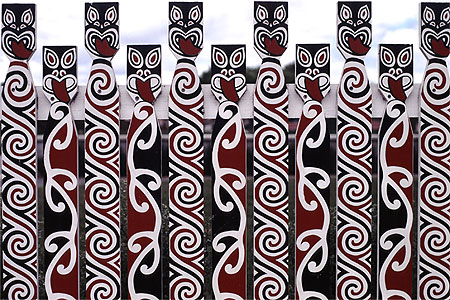 WhakanuiTe Wiki o
WhakanuiTe Wiki o
te Reo Māori
Celebrate Māori Language Week
Media Release from the Maori Language Week website
“Manaakitanga” (Hospitalit ) theme for
Māori Language Week 2011
Te Taura Whiri i te Reo Māori (The Māori Language Commission) have chosen “Manaakitanga” as the theme for Māori Language Week 2011.
““Manaakitanga” is a very important tenet of Māori custom and identity, that has, I believe, positively influenced notions of good old ‘Kiwi’ hospitality. At its core manaakitanga is about how we make people feel welcome when they are in our company, and how we give regard to and care for others when hosting visitors”, says Chief Executive, Glenis Philip-Barbara.
“Perhaps the most recognised or common place where people see this custom practiced and experienced is on marae across the country. Certainly though for those iwi, hapū, whānau and wider communities for whom the language is an everyday enterprise, manaakitanga is a more habitual convention, evident in all interactions however great or small”, says Glenis Philip-Barbara.
“Perhaps the most recognised or common place where people see this custom practiced and experienced is on marae across the country. Certainly though for those iwi, hapū, whānau and wider communities for whom the language is an everyday enterprise, manaakitanga is a more habitual convention, evident in all interactions however great or small”, says Glenis Philip-Barbara.
“Our key message is about promoting Māori language use in communities and homes. In keeping with our recent choices for Māori language week themes we’ve selected another activity-based concept to further emphasise this message”, says Glenis Philip-Barbara. “Here is a golden opportunity to think of all the ways you can act positively in your community and utilize the language and practice of manaakitanga to do so”.
It also links nicely to the tremendous event that is the Rugby World Cup 2011. “The Rugby World Cup 2011 is an excellent opportunity to use Māori language to host our visitors”, says Glenis Philip-Barbara “from cities to rural towns, hotels to homes, all modes of public transport and on our streets. Everyone who has Māori language knowledge, great or small, is encouraged to use it as often as they can during this exciting time as New Zealand showcases itself on the world stage”.
It also links nicely to the tremendous event that is the Rugby World Cup 2011. “The Rugby World Cup 2011 is an excellent opportunity to use Māori language to host our visitors”, says Glenis Philip-Barbara “from cities to rural towns, hotels to homes, all modes of public transport and on our streets. Everyone who has Māori language knowledge, great or small, is encouraged to use it as often as they can during this exciting time as New Zealand showcases itself on the world stage”.
With school term dates being adjusted to accommodate the Rugby World Cup 2011, Māori Language Week will take place earlier than in previous years. Schools and teachers are asked to note Māori Language Week 2011 is during the second to last week of Term Two, 4 July – 10 July 2011.
For more information on Māori Language Week you refer to the website www.koreromaori.co.nz
http://youtube/watch?V=vujkPK_NfR8U you tube to listen to a Waiata
Here are the words of the waiata (Hymn)
 Maori Waiata or Hymn - acapella style
Maori Waiata or Hymn - acapella stylefrom www.maorilanguage.net
E toru nga mea
(There are three things)
Nga mea nui
(Very important things)
E kï ana
(As stated in)
Te Paipera
(The Bible)
Tumanako
(Hope)
Whakapono
(Faith)
Ko te mea nui
(And the greatest thing)
Ko te aroha.
(Charity/ Love)
Perfomed by Mana Epiha
and Naomi Bradfield
Produced by Adrenalin TV
www.adrenalingroup.com
Artist: Charles Goldie
Art Print Title: Christmas Time in Maoriland
Image size in millimetres: 420 x 510Fine Art Print. New Zealand Artist
Some Maori Words to Learn
· Kia ora - Hello
· Kapai – Good
· Whare - House
· Kai – Food
· Whanau – Family
· Puku – Tummy
· Korero – Talk, speak,
have a
conversation
· Moe – Sleep
· Waiata – Song, to sing
- Karakia – Prayer, pray
- Whanau- Family
- Iwi- Tribe
- Tamariki- Children
- Mokapuna- Grandchildren
- HAKA- A WAR DANCE - ONE YOU SHOULD ALL KNOW !
Artist: Charles Goldie
Art Print Title: Fire and Smoke
Image size in millimetres: 420 x 510
Fine Art Print. New Zealand Artist
Image size in millimetres: 420 x 510
Fine Art Print. New Zealand Artist
The Maori language (Te Reo) belongs to the Polynesian sub-family of languages, a fact which enabled Captain Cook's Tahitian interpreter, Tupaia, to translate for him on his initial voyage of discovery to New Zealand in 1769. As far distant as Hawai'i, changing the Maori k to the glottal stop represented by ' in written Hawai'ian, and the Maori r with l makes many words comprehensible. The roots of the polynesian languages, like those of the polynesians themselves, lie in SE Asia.
The language was first reduced to writing by the early missionaries, but they simply used English letters to represent Polynesian sounds and only comparatively recently have appropriate techniques been evolved to establish the significant sound contrasts in the Maori language. These are not yet in common use and are contaminated by modern political correctness.
The alphabet is restricted to fifteen letters - h, k, m, n, p, r, t, w, a, e, i, o, u, wh, and ng. Every syllable ends in a vowel, and the quantity of the vowel may vary, so changing the meaning of a word.


No comments:
Post a Comment